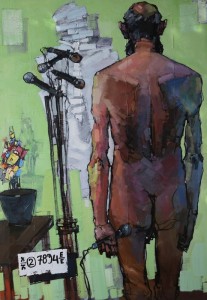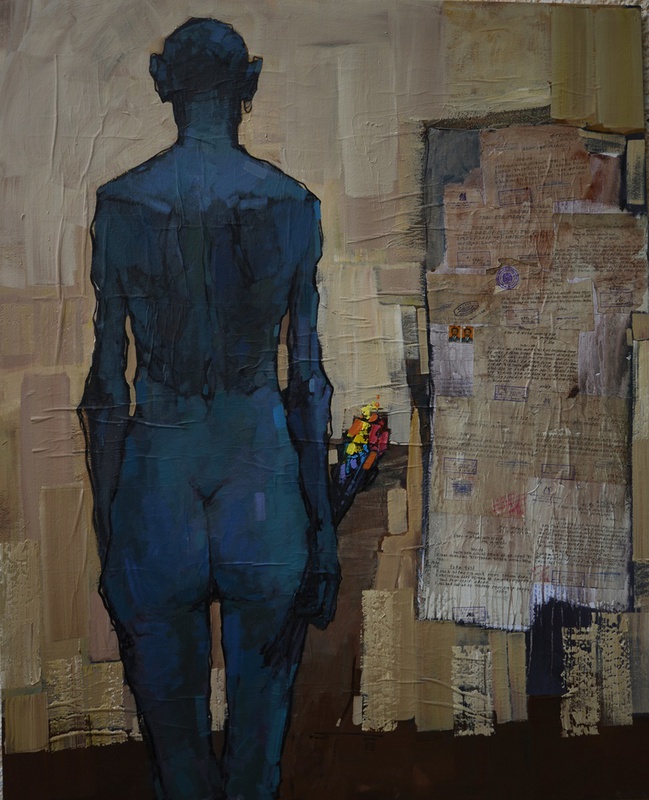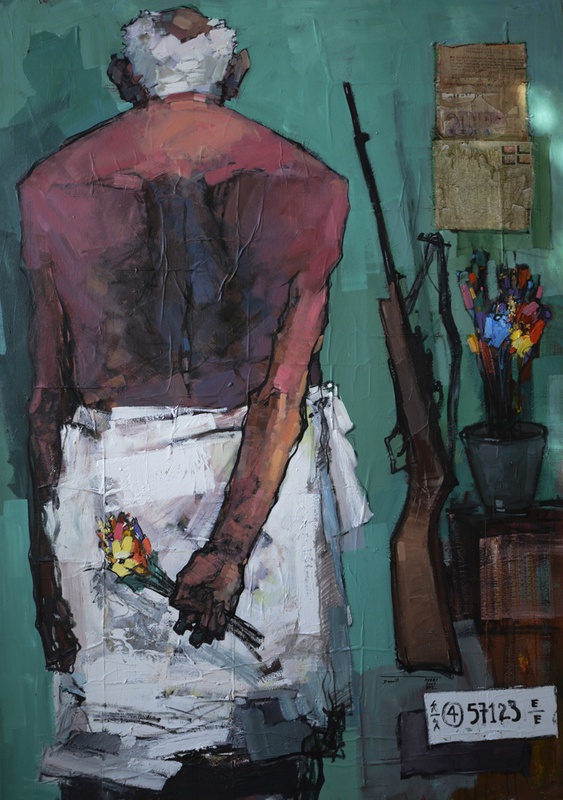
Dawit Abebe Background 2 Series
No 2 Background 17, 2015.
Background 2
Lives jump at you out of the walls, a vibrant, colourful portrait gallery. Certainly, deft brushstrokes and colours come together in rapid profusion to convey thick neck folds and creases of skin melding into the contours of muscles. Some are tall and powerful, men in the prime of their youth, while others are aged, their shoulders slumped in submission to the ceaseless ravages of time. Small details – a pair of crumpled shorts, a policeman’s hat, an old-fashioned red circular-dial telephone – are clues prompting us to put the pieces together and complete each portrait, ultimately becoming an intimate and private glimpse into one man’s life. Yet, in each image, there remains one vital piece missing – leaving us, the eternal voyeur, to never fully connect with our subject – for each man has his back turned to us, facing his ragged shadow, dancing against the wall. Following his participation in the 2014 group show Trade Roots at Kristin Hjellegjerde Gallery, Background 2 (26th of March – 2nd of May 2015) sees Ethiopian artist Dawit Abebe raise questions about the often difficult relationship between history and technology, and the ways in which the two co-exist today, through mixed media and acrylic paintings.
 No 2 Background 6, 2014.
No 2 Background 6, 2014.
With an interest in the realm of technology and its impact on human behaviour, Abebe has long examined the role that belief systems, as well as mankind’s propensity to search for knowledge, have played on society – particularly in the fields of privacy, alienation and materiality. As technologies advance and develop to bigger and better levels of sophistication, Abebe’s interest has lain in the impact these technologies have not only on the environment, but also on human behaviour. The most apparent evidence of this, to his eyes, has been the way in which social interaction has begun to move out of the public sphere and into the technological one, through computers and mobile phones, a theme he has examined in his prior series Pin Code (2006) and the ongoing X Privacy (2011 – present).
Abebe explains each series’ relationship to its predecessor not so much as heading in a new direction, but rather as creating another link in a chain, continuing to build on the issues brought to the fore in the last. In Background 2, then, he presents us with a new series of work, moving from the monochromatic combination of blue and black of X Privacy to full colour works comprising thick brushstrokes and complicated, nuanced, painterly interventions. In each portrait, a piece of text is displayed prominently on the wall, the figure presumably staring at it, as the viewer stares at his or her back.
 No 2 Background Series 14, 2015.
No 2 Background Series 14, 2015.
Previously, Abebe explored the ways in which rural communities (such as Ethiopia, Madasgar or Kenya) have been affected by advances in technology – predominantly as a signifier of wealth – and, in turn, the way it has impacted on behaviour. Background 2 takes the analysis a step further to question our ability to convey history when books make way for texting and television. Ethiopia, like many developing countries, has struggled with the impact of technology and modernisation and its place within a long and rich local heritage and culture. It is the demarcation at which the two meet that interests Abebe. “I think the history of a country as well as that of a particular individual follow similar paths,” he muses. “One can reflect the other, as microcosm and macrocosm – what affects an individual is often played out on a larger scale when it come to a national issue. In this vein I feel that the coming of technology has seen a rapid transformation within Ethiopia, with the danger that the younger generation are becoming less aware of their own history in the face of the pop culture and social media interaction that takes up their attention now instead.”
It was during a trip to the local market that Abebe had an epiphany: finding used school books and newspapers, he was able to revisit the histories that had been taught to him in school, observing how what he had been taught has since evolved, and how historical fact is an ever-changing entity rather than a fixed truth. “Something clicked for me when I found these elementary school books,” he says. “I read them and it raised questions as to how and why all these ‘facts’ had changed, and the fact that, in a sense, we were throwing away history by throwing away these books.”
Indeed, herein lies the crux of this work – in Amharic, the word ‘gerba’ denotes history or background. So while Abebe’s subjects have their backs turned to us, they are in fact facing this very history, both through the schoolbook pages pinned on the walls, as well as through facing the background itself. “They carry history on their backs,” he explains. “It is not that they are turning their backs to it, but that it is something that they carry with them always.”
 No 2 Background 15, 2015.
No 2 Background 15, 2015.
Furthermore, in each figure’s hand is a license plate, visible only to us as we are looking at them from behind. They hark back to the time of Pin Code, and Abebe’s interest in how numbers have come to define us – from house numbers to telephone numbers, computer passcodes and, of course, various pin codes themselves. “Today we have numbers and codes for everything in our lives,” says Abebe, “not least on car license plates. In Ethiopia in particular, private cars are seen as a status symbol or signifier of wealth – so private cars belong to government officials, merchants and so forth – and I use them here as personal codes for each person, a marker of who they are.” In this vein, Abebe has also selected varying age groups for his subjects, with a particular emphasis on the older generation. “We have 3,000 years of history here in Ethiopia, passed down both through written and oral tradition, and the older generation know more than us. We can learn from them. As with many things, technology has disrupted this process of passing down oral histories and I feel that the older generation plays such an important part in healing this process.”
In Background 2, Abebe is not presenting us with a pessimistic view of the future, but rather a positive appraisal of a state of affairs that is not beyond repair. “I am merely raising an issue,” he explains, “in the hope that in doing so, there is the chance to solve the problem. I don’t think any of these issues of technology and history are local to Ethiopia, per se, but are global issues particularly pertinent anywhere technology currently plays a major role in everyday life.”
(text Kristin Hjellegjerde Gallery London)
